
Chapter Selection Menu: P 1 2 3 4 5 6 7 8 9 10 11 12 13 14 15 16 E Next>>
Mission Visits the UK - England & Wales, May 2013
Chapter 9th - Gareth 1
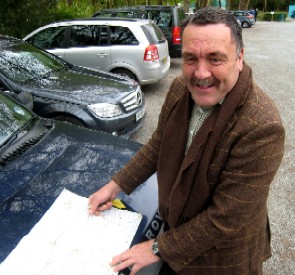
Gareth Explains the Planned Route
Chapter 9th: Wednesday's day adventures in Wales, Beginning with meeting Gareth Pugh, who was last seen in the 2012 Key West Surgeon's Journal as you will discover by clicking on that hot link; Going for a train ride on the Ffestiniog & Welsh Highland Railway; Not Going to the Royal Goat Pub but instead going to the Queen's Hotel Pub; Visiting the Welsh Highland Heritage Railway and learning about Russell; Stopping for a visit to the shore-side vacation town of Barmouth and driving in the 'real' Wales, which I heartily do not recommend.
When I got to the parking lot (or 'car park' as they call it here), Gareth was there waiting for me. Fortunately he hadn't been there long even though I was a bit late. He got out an atlas and began to explain where we were going. He lost me after the second or third instruction, but he told me the name of the closest town (which I also promptly forgot) and said that if I lost him, go there using the 'SatNav' and ask for him at the local pub. Apparently everyone there knew where he lived.

Ffestiniog and Welsh Highland Railway Rail Map. In the
Lower Right Corner is
Porthmadog, In the Upper left is Caernarfon, where I visited the castle days ago.
With that settled, I got in my little red rental car and followed Gareth. We were first going into town of Porthmadog, which is right across the estuary from Portmeirion. Here there were not one, but two privately run little narrow guage railways(Guage refers to the width that the rails or tracks are from one another for those of you not familiar with railroading. In addition to rambling on endlessly, we here at the Surgeon's Journal also try to provide educational insights into things like rail guage triva which you will probably never need to know otherwise.) Gareth and I were going for a
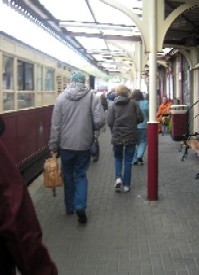
The Train Station in Porthmadog
train ride on the Ffestiniog & Welsh Highland Railway. (Being an engineer, I love trains. No, I am not a train engineer, I am a mechanical engineer who designs parts and assemblies, but for whatever reason, many engineers I know like trains and bridges and all manner of similar things which are often associated with engineering. It's like a disease or something.)
So we went into the train station (and it was indeed a proper
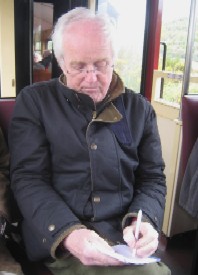
John, Small Rail Enthusiast
train station) and got tickets to ride the train to Beddgelert and back. We sat in an open passenger coach, which was a bit chilly, but which meant that I could get better photos. Gareth explained that the rail guage of the both train lines in Porthmadog were 1'-11-1/2", "Near enough two foot." (See, more rail guage triva! Don't you feel so smart?) There was a movement afoot in the UK and (from what I later saw) in Wales itself to revive old train lines and rebuild or repair the tracks on the existing rail beds. The line we were on was a walking path built on the previous incarnation of the train line which preceeded it.
Traveling along, Gareth got to chatting
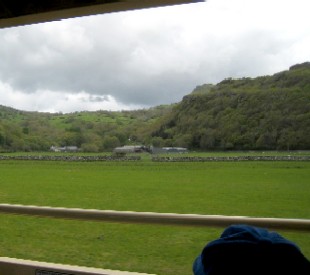
I Believe This is Where the Estuary Used to Come
To.
Or It May Be Just Another Boundary Fence.
(Like you'll
know the difference.)
with a man sitting by us whose name was John. John was a small rail enthusiast (Er, the rail was small, not John. That's just rail guage trivia-talk there. John was normal-sized as you see here). John was a travel agent for Ffestiniog Travel, a local company that arranged rail trips. He seemed to know a lot and I expect he could regale you with all sorts or rail guage trivia. John and Gareth discussed various aspects of the area and railroads, cheerfully arguing the finer points of these things.
From their discussion, I learned that the place we were traveling through on the train used to be an estuary like the one Portmeirion sits upon called Afon Glaslyn until the local residents built an embankment that leads from Porthmadog to the area where Portmeirion is. This blocked the estuary water and created the polder called Traeth Mawr, which I discovered is Welsh for 'big sands.' (Polder sounds like an ancient weapon or a sheath for one. Well, it does to me.) John and Gareth pointed out the place where the water used to come up to when we passed it. From their discussion I thought this was a recent event, but when I asked, I learned that it actually happened in the late 1800s. (Of course, this is really not a long time ago when you're talking about British history.)
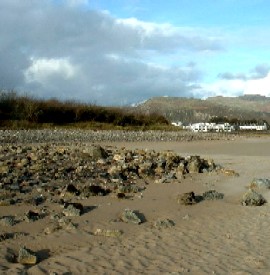
Photo: National Geographic
Ballast Island Shoreline Featuring... Ballast
I also learned that there was an island somewhere around here that was called Ballast Island because, you guessed it, it was made from Ballast stones. These were left there by Australian and American ships when they came into port to lade slate. Because these ships were built for heavy
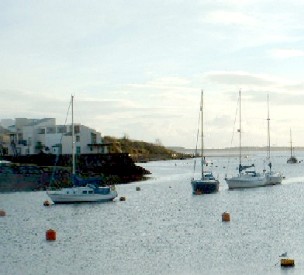
Photo: National Geographic
Ballast Island Prime Real Estate Featuring Boats
sailing, they needed ballast in their holds for the return trips home after delivering slate to foreign shores. In order to reload the slate, they dumped these ballast stones in Porthmadog harbor, creating this island. (OK, I am reaching here – it's not quite a pirate reference – but it's sort of vaguely related. I have to do what I can at this point.) Curiously, as you can see in the photos here, it has since turned into prime real estate, a fact that probably contains a lesson of some kind for those willing to search for it. But we're riding on a train now, so who cares?
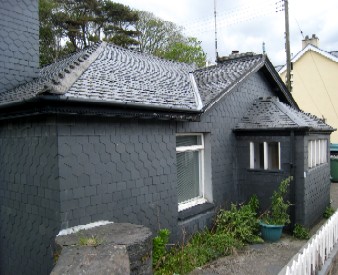
That... Is a Lot of Slate. To Have.
John and Gareth had moved on from trains and polders and were now discussing different types of slate roof tiles. (I learned that here are two types – Welsh and Spanish. Welsh were naturally better, but Spanish are cheaper. Gareth had recently slate roofed his barn at Pen-Y-Parc with Spanish tiles and noted that while they only last 40 or 50 years, they would likely outlive him.)
This area used to be an important place for mining slate an impression you may have gotten while reading about Ballast Island. (But only if you were paying attention. If not, go back and re-read it.) The Portmeirion shops had all manner of slate items and you may recall that the two meals I photographed there were served on pieces of slate. While we were walking to the train station, Gareth had pointed out the house you see at left, which is tiled, ceiling and walls, in slate. In fact, I heard that the American beef industry stole their slogan from the Welsh slate mining industry. ("Slate - it's what's for dinner." OK, maybe not.)
The slate discussion
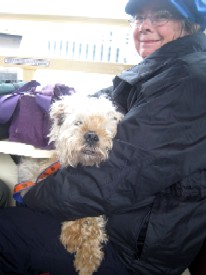
Tim and His Owner
continued, so I decided to take photos of the little dog sitting on the other side of the aisle in the small train. (This kind of stuff really goes over well with you guys and I have to play to my strengths.) His owners told me that his name was Tim, which I think is a fine name for a dog. Tim was a 16 year old Scottish Border Terrier who didn't walk very well these days, but who loved to travel by train. "All our dogs love to travel by train," Tim's owner explained to me. They had owned three dogs and had taken them all traveling this way.
We finally reached Beddgelert, which Gareth informed me had a pub called The Royal Goat. (I'm not sure how he knew of my fascination with goats. When we were emailing each other about the details of this trip, I asked him if he had any goats on his farm, so that may be where this came from. I do think goats are funny. In fact, I have now written two 'scholarly' articles about them – one about their use in medicine and another about their use as food on ships. But I am seriously off-topic here.) Gareth's schedule for the day wasn't quite generous enough for us to visit this pub, for which he apologized. While I would like to have had a pint in the Royal Goat, I had already paid homage to celebrated Capra during my description of Caernarfon Castle, so I felt comfortable missing this bit of goat trivia. Still, it is things like this that speak to my inner depths, so I may have to return to Portmeirion and the environs so that I can one day say that I stopped in at the Royal Goat. (You know?)
Before we go on, you must have some more scenery photos. Like the Portmeirion photos, I took four times this many, so feel fortunate that I only stick you with these.
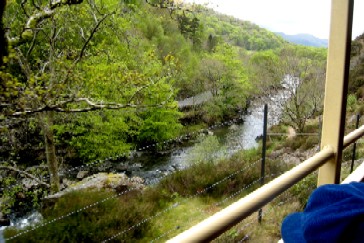 A View of the River Near Beddgelert |
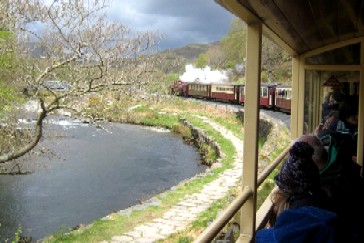 The River, Walking Path and Train Rounding the Bend |
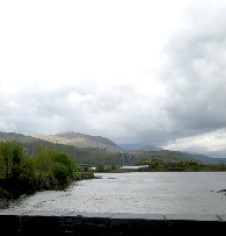 A View From The Embankment Which Blocked the Afon Glaslyn Estuary |
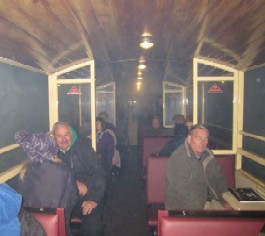 Long Train Tunnels May Sound Romantic, But They Also Capture All the Engine Smoke |
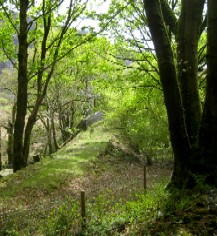 A Train Bridge Built for a Side Line Never Used (Dull? Well I Liked It...) |
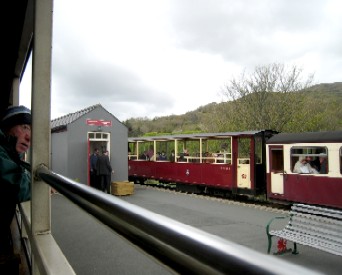
The Beddgelert Station. (It's nice, but not the Royal Goat. Alas.)
We immediately got off the train at the Blaenau Ffestiniog station in Beddgelert. (Aren't these Welsh names something? My spell checker's mind is now totally blown.) We jumped on another train sitting opposite ours which was headed back for Porthmadog. If we had stayed on the first train, Gareth explained that we would have eventually wound up in Caernarfon, where I had visited the castle on my way to Portmeirion.
I asked Gareth how long it would be from here to there. He figured it would take a couple of hours. Considering that I had driven from Caernarfon to Portmeirion in an hour or so, I would say that you would make this trip by train in order to enjoy the view. Gareth did tell me that there were many people who used the trains to travel from one small town to another and that efforts were on-going to connect several of these small railroads in Wales together to create a more extensive travel route.
Back in Porthmadog, we walked into town. As we crossed the bridge between the Ffestiniog and Welsh Highland
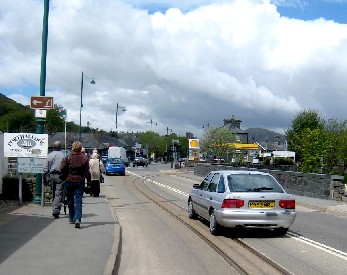
The Railway Bridge Crossing in Question
Railway and the center of the town of Porthmadog, Gareth pointed out the rather unusual railway line crossing, which I show in a really hard-to-comprehend photo at right. (Still, this may help you to understand what I am about to explain. Probably not, but I can only hope, can't I?)
The tracks have to cross the small bridge that also contains the roadway. For this to work, they have to keep all the traffic off bridge. Clear so far? Apparently this disgruntled some of the residents who proclaimed doom and gloom would follow any such unusual rail crossing. Of course, this has not come to pass. (If it had been 200 years ago, these would probably have been the same people predicting that rail travel was too fast for the human body and people would die if they went faster than the quickest horse.)
As we walked through Porthmadog I took some photos so that I could add them to my collection of Small Welsh Towns I Have Visited.
We made our way to the Queen's Hotel Pub where Gareth had last gone during his last visit here. The hotel had apparently changed hands a couple times since, but they still served teppan which was a variety of Japanese grilled dishes and cheeses and other finger foods that was very good. That and a pint of ale made the visit quite nice. (The Queen proffers a good spread for lunch.)
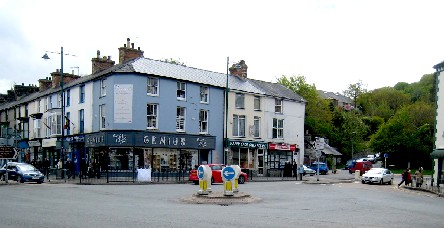 Porthmadog City Street Scene, Complete with the Inevitable Roundabout |
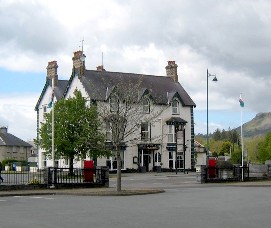 The Queen's Hotel (and Pub. Let's not forget that.) |
After lunch, we made our way to the other train station – the Welsh Highland Heritage Railway,
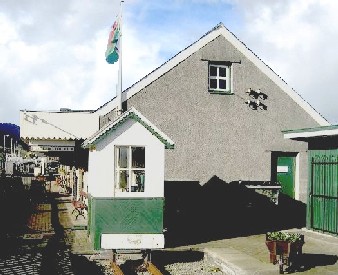
The Welsh Highlands Heritage Railway Station
which was across the street from the Queen's Hotel.
Gareth had seemed quite keen on trains when we emailed and here I learned why. For his 40th birthday, Elizabeth (Gareth's wife) had given him the opportunity to drive Russell. Russell is a 104 year old steam locomotive who was originally built for the North Wales Narrow Gauge Railways. Gareth explained that there had been quite a tussle over which of the two Porthmadog narrow gauge railways would get him and the Welsh Highland Heritage company had won. I guess the Ffestiniog Railway was still steaming mad about this. (Ha ha. OK, they don't think that's funny.) Gareth thought all the fighting was counterproductive and they would eventually have to join together to survive.
Anyhow, Gareth had such a great time learning to drive and then running Russell down the line that he signed up as a member of their society on the strength of it. Unfortunately, Russell was out for repairs when we arrived, so I didn't get to see him, but Gareth found him in a book for me to see.
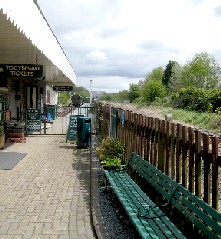 The Platform - Russell Knows The Value of Not Being Seen (Unrecog. Rating - 3%) |
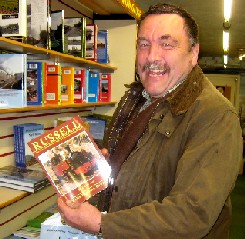 Gareth Showing Me a Magazine Dedicate to Russell, The Engine He Drove |
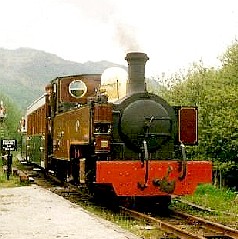 Photographer: Dan Crow Stock Footage of Russell |
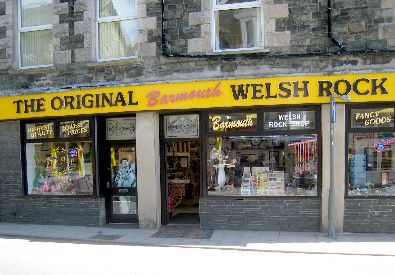
The Original Barmouth Welsh Rock Shop
Our next stop was a little port town of Barmouth which Gareth's family used to visit when he was younger. The town was backed by several large, steep hills covered in lovely yellow gorse. It was chockablock full of charming little shops including a sweets shop that we stopped in called The Original Barmouth Welsh Rock Shop.
The Rock Shop was owned by Vic who had taken it over in 1957 from his father who had started it. It used to be on another street, but he had moved it to its present location. (He told me when, but I had nothing to write on and I forgot.)
Gareth wanted to get some rock (his reason for stopping in) and insisted I get a bag as well. Rock looks like round candy with a colored outside and a white middle that little patterns in it. It tastes like candy canes, which is what Ed Fox later told me it was basically was. Vic was very nice and gave me an extra bag of candy which I later gave to Ed's children Lily and Odin.
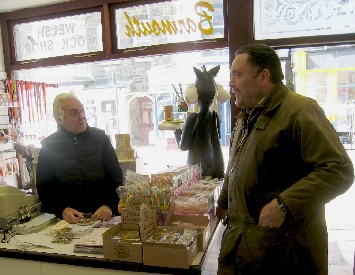
Owner Vic and Gareth Chatting in the Barmouth Rock Shop
Proceeding along the street, we stopped in at an antique shop where Gareth got into a discussion with the owners about some items he had that he was thinking of selling. I wandered around the shop looking at the old pewter mugs and antique guns and such. Gareth was pleased to learn that something he had that he was thinking of selling might be more valuable than he originally thought. He also talked to the owners about buying an antique cannon, which I believe is a sound business decision for anyone involved in pirate reenacting.
From there we ambled along a boardwalk where Gareth got an ice cream. ("We always get an ice cream at the beach – it's sort of tradition.") There he got into a discussion with the girl behind the counter who was Eastern European. (I forget which country. No notebook. Sorry.) She had been working at this ice cream store the last three seasons and she liked it, but she didn't plan to stay here. She came over with a friend two years ago and liked it well enough to return. She seemed quite wary, so I didn't take a photo of her, which was too bad because she was quite charming.
As we were walking along the boardwalk fronting the beach, I commented on the hills and the gorse behind us. It turns out that Gareth had trained there when he was in the army. I don't think the photo below center quite puts the steepness of the cliffs across, but gamboling around on them doesn’t look like something I'd want to try.
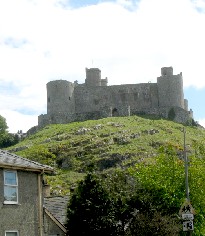 Harlech Castle. This isn't, technically, Harlech Castle. This isn't, technically,in Barmouth, but it's on the way |
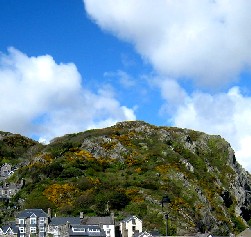 The Gorse-Covered Hills of Barmouth Where Gareth Did Some of His Army Training |
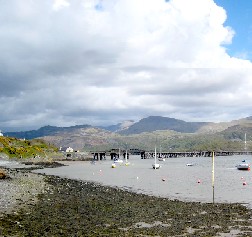 The Barmouth Seashore. It wasn't really the The Barmouth Seashore. It wasn't really thebeach season yet. |
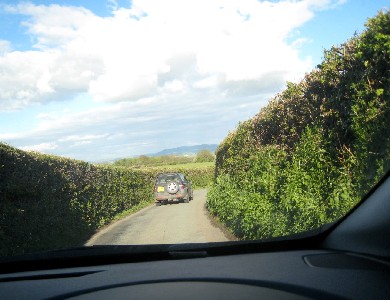
Following Gareth on the Welsh Back Roads. This is a 2 Lane Road!
Seriously, we passed several people on this road!
Then we were off again. This time I got to drive in the real Wales - the back roads which were apparently designed with a vague nod to roller coasters.
If I had been nervous with driving before, this trek was the sort of motoring to try a man's soul. Or at least his nerves.
Everywhere you went on these roads, there were tall hedges or stone walls right next to the median. (Calling it a median is actually generous as you can see in these photos.) In the US, these would be one way only streets, and iffy one way only streets at that. Add various sudden turns and large looming hills and you grew to appreciate the nerve of the Welsh driver. I commented on this later to Gareth and he said, "I wanted to show you the scenery." Well I certainly saw that!
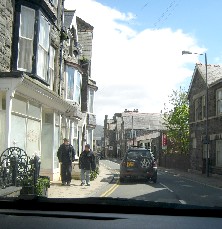 Driving in a Busy Town |
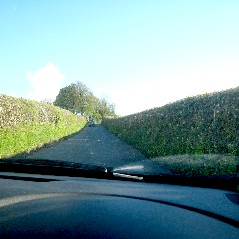 The Hedges Could At Least Be Bumpers |
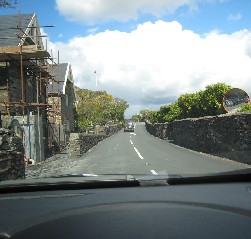 Driving in a Village Driving in a Village |
